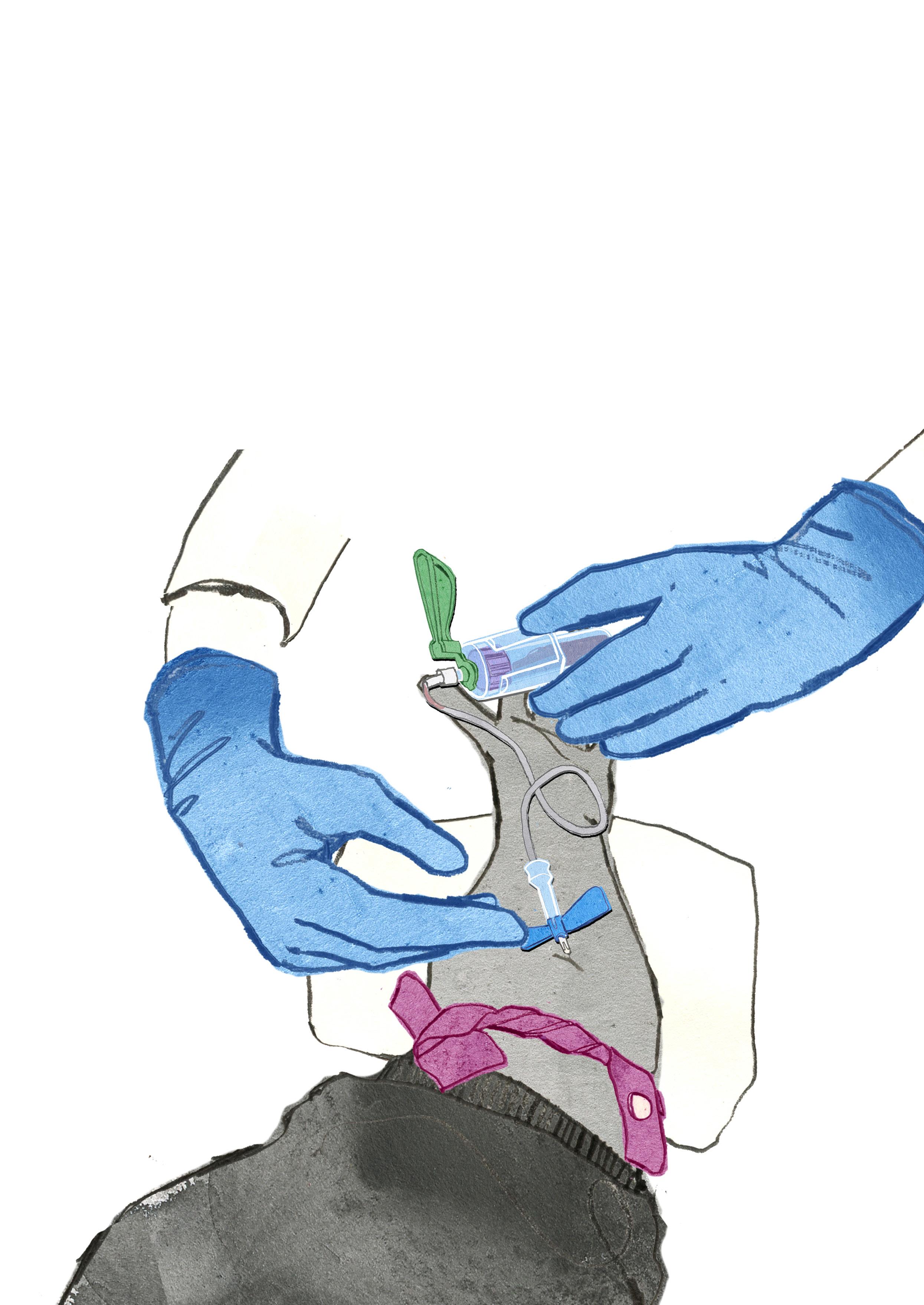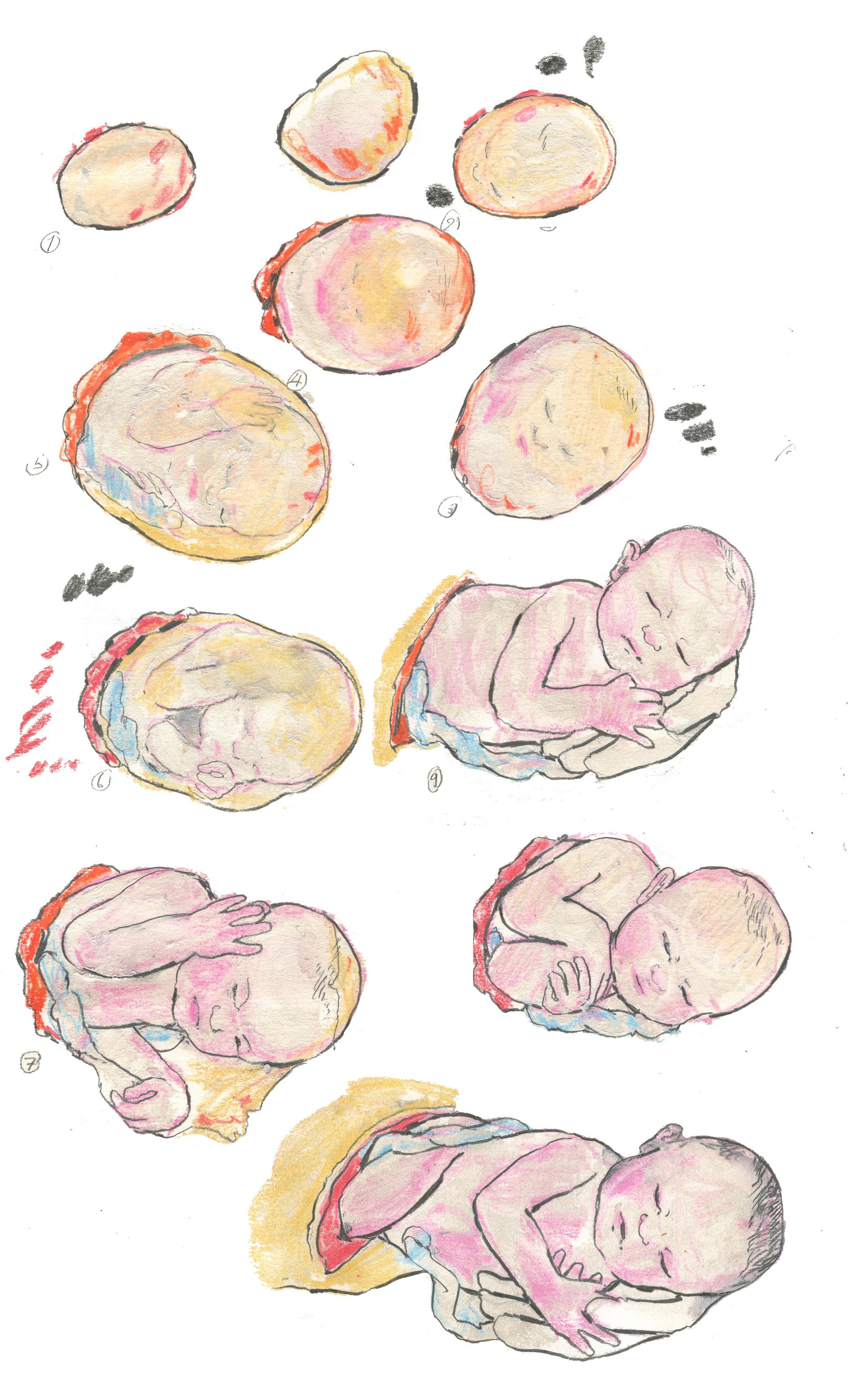CPAP Hat -This keeps the CPAP machine secure and comfortable on the baby’s head.
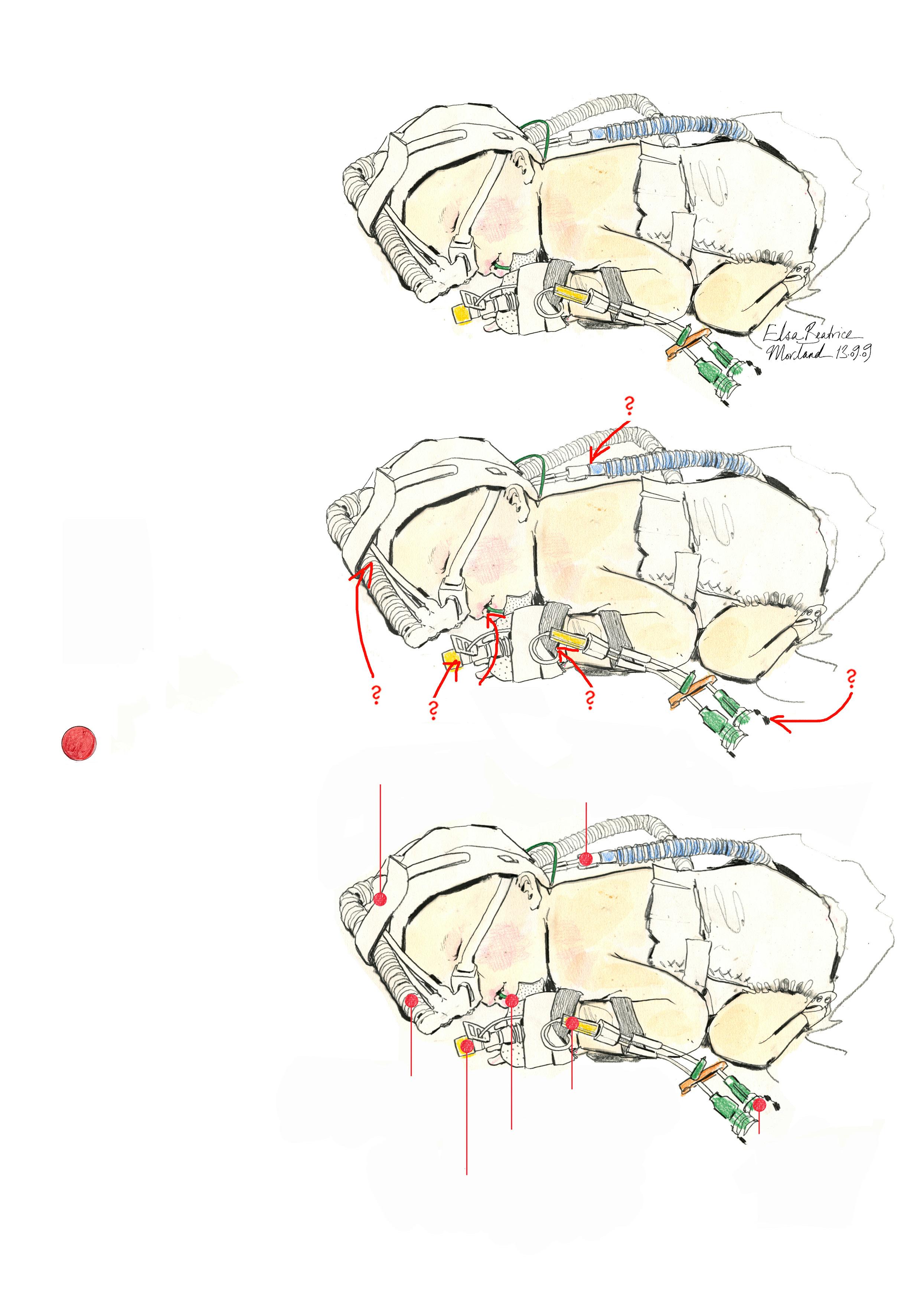

Jane
CPAP -Continuous Positive Airway Pressure- This delivers air to your baby to keep the lungs open and allow them to develop fully
Needle Free BungThis allows medicines to be given into the IV, such as antibiotics
Intravenous DripThis delivers fluids to your baby, directly into the bloodstream
Orogastric Tube FeedingThis is when your baby is fed through a small soft tube, which is placed in the mouth and runs down the back of the throat, through the oesophagus into the stomach
Y-Tubing- This is a type of IV where blood can be infused through one side and saline through the other
How can choice and confidence be encouraged in the experience for birthing Mothers through Illustration Animation practice?
“There is no such thing as a normal birth.”
EmilyMcMorrow –Maternity Support Worker.
Working in collaboration with Specialists, Midwives and Maternity support workers at Kingston Maternity Unit, this research aims to document and evaluate how illustration animation practice, as a documentary research method, can acknowledge and communicate diverse perspectives of the childbirth experience. Then strive to offer new innovative inter- disciplinary visual approaches to empower women to make informed decisions at all stages of the birthing journey.
Key to the development of this proposal has been attendance at ‘The Big Room’ bi-weekly team meetings at Kingston Hospital’s Maternity Unit with clinical staff. Experiencing these meetings has illuminated how childbirth often does not align with their initial expectations for many women. Pregnant women are encouraged to consider a detailed birth plan - to identify the birth location, agree pain relief options, who will be present at the birth and how they would like to hold and feed the baby post-delivery. However, many women experience their baby’s birth considerably differently from their ‘birth plan’, resulting in an unexpected story. There are a considerable number of factors that can determine the narrative of any birth experience pre, during and postpartum. Typical issues may include short staffing, induced birth, a change in the mother’s blood pressure, weight and gestational diabetes or health. Some complications or issues with the baby’s growth rate or heart rate condition. 1 in 10 babies requires additional help in the neonatal unit following a premature, complicated, or emergency birth story.
The unknown, and changes to an anticipated birth plan can dramatically alter a birth story and be frightening. This can result in a sense of failure or disillusionment for the new mother can have implications and associations with postpartum depression.
Practice-based elements for the project will utilise documentary drawing pro-cesses to improve understanding of the narratives, choices and the preparation needed for women giving birth by visually communicating the processes. The environment and equipment can provide a space for women and their support networks to experience the range or potential of choices in giving birth.
It is anticipated this research can assist in improving rapid decision-making that is often required within the clinical setting to communicate complex information to women giving birth and their partners
Visual representation would provide immediate communication, which potentially can cross language barriers and issues with reading ledgibility
KMU’s focus is on improving foetal maternal outcomes for all of their women. Staff report there is no visual language to communicate the stages and importance of foetal heart monitoring, what happens in the induction of a pregnancy, or the screening processes for gestational diabetes, amongst other procedures and protocols. Medical Illustration exists on the body’s physiology, but these do not communicate a narrative and are not necessarily patient-orientated in the tone of the visual language.
Drawing-Documentary drawing is a powerful method to share knowledge and to create a hierarchy of information for the viewer. It is a form of visual journalism, where the illustrator captures and records events as they develop. The reportage or documentary practitioner’s premise is that of a storyteller or a narrator of the experiences unfolding at that location or event. As a visual form it has a unique facility to edit, select and focus upon the part of the story that requires attention at a particular point in time. This project will be based in drawing on location at the hospital, then developing those drawings in the studio to develop them through time and animation process. Giving birth is a time based event, encompassing several stages, developments, and transitions. We respond to drawing in a wholly dif- ferent way than we visually identify with the photographic image. Historically this drawing practice made sense of ritual, places, and events of time. This project will be rooted in the practice of visual journalism for education purposes.
Documentary or reportage drawing does have standard links with photography and filmmaking. However, the unique aspect of documentary drawing is that the narrative communicates through the hand of the illustrator. The live, immediate, eventbased process of recording an event can provide insight into which words alone fall short. Through the choice of the drawing medium and aesthetic decision- making, documentary drawing has a language that can be articulate across spoken language.
The documentary illustrator has the facility to edit, select, and focus on the momenthat needs clarification so that the viewer, in this instance, the patient, can better understand the experiences or the choices available to her. Drawing can spotlight or delineate the complexity of an event, location or action. A visual information hierarchy can allow the audience to process and understand what they may experience.
In return, she potentailly feels more prepared and aware of the range of options for her particular birth story.
NHS England (NHS England, 2019, 2016) recommends effective foetal monitoring in labour as one of the key elements of care designed to tackle stillbirth and neo- natal deaths. These courses aim to pro- vide evidence-based training on CTG interpretation based on foetal physiology and pathophysiology of intrapartum hypoxic injury so as to reduce hypoxic ischaemic encephalopathy whilst reducing not necessary operative interventions.
Listening- to women in the first, second and third trimester of perceived preconceived birth experienes. What do women expect? The question- ing of new mothers, what do they feel, required clarity? What was that experi- ence, and did they feel prepared? What could have enabled them to feel more prepared?
Documentary drawing - and observing a range of birth stories, including low risk spontaneous vaginal birth, assisted instrumental delivery with forceps and vontous. Breech birth, Higher risk birth –women with hypertension, pre-eclampsia, gestational diabetes, raised BMI. Planned and emergency Caesarean Section birth. Multiple birth pregnancy. The recovery after birth stories. The neo-natal unit. Was that experience as expected? Was it good,bad, disappointing, surprising, shocking, fanastic disempowering, delusional, failed, feeling left feeling cheated or grieved?
Reflecting- how can the stories be told from the perspectives of the clinical team and the woman. What is the depth of information for the demographic of their patients? What do they require?
Design -how can this information of verbal, clinical, aural and drawn experiences be communicated to explain and empower future mothers and encourage understanding of clinical language. Where the potential placement of this design exists and in which form.
Testing- introducing visual communication to KMU. How does the material work in clarity and accessibility, and does it translate and bridge the gap between medical terminology and expectation?
Reflective Practice- The analysing and critically reflecting upon the work. What can be made more transparent, and how can be it be improved? Can it be applied to other medical processes and procedures or communities?
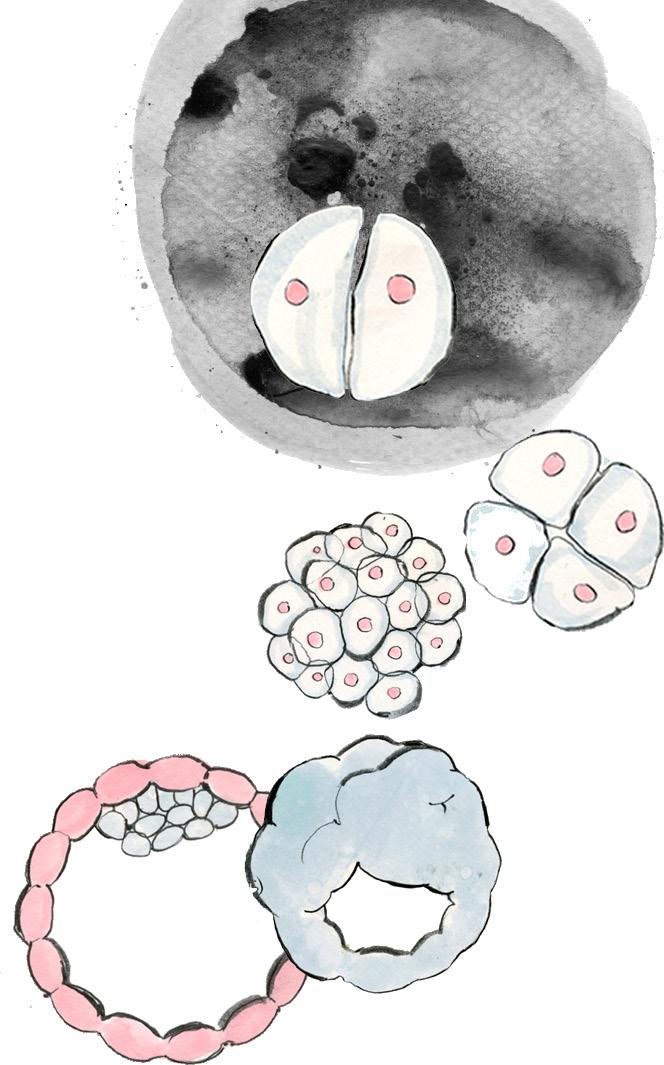

Kingston University funds my PhD project. I am in the second year of a six-year parttime Research journey. In this PDF, I am presenting some of my visual approaches and intentions within the research; the opposite page outlines the intention of the project and how illustration animation practice has so much potential in relaying and explaining communication about pregnancy and birth to prospective parents- especially the Mother or person giving birth. To realise the following stages as a practice-based researcher, having the opportunity to listen and draw staff and patients accessing and working in the hospital setting is vital. I am not asking for any funding, but access to the communities West Middlesex Hospital supports would be fantastic and beneficial to all stakeholders.
This research came out of my experience of having a baby prematurely at 32 weeks after a full placental abruption. My daughter was presented covered in the equipment on the front of this document. Having a visual guide to what that was would have been reassuring. As we were both saved and looked after by the NHS, as a visual communicator I want to use my skill set to enable clarity and confidence in other NHS service users and give something back.
Reading the mission statement that CW+ since 1993,
“Has been at the forefront of improving the experience of those visiting the hospitals.
Our Arts for All participatory programme of wellbeing-focused activities, delivered across the Trust by a team of experienced resident artists, provides distraction and entertainment for patients and visitors.
Drawing on our design expertise, we enhance the physical environment, optimising treatment and recovery spaces in our hospitals.
Researching, evaluating and sharing the impact of our programmes and enhancements is an important aspect of our work, helping to shape best practices nationally and internationally.”
This statement aligns with my PhD research and the project’s intentions—to benefit communities that access the NHS
Jane Webster X CW+ Proposal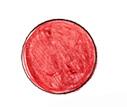
Birth Stories: Conference Paper
Developed from the PhD interview visual presentation. Presented at SECAC.
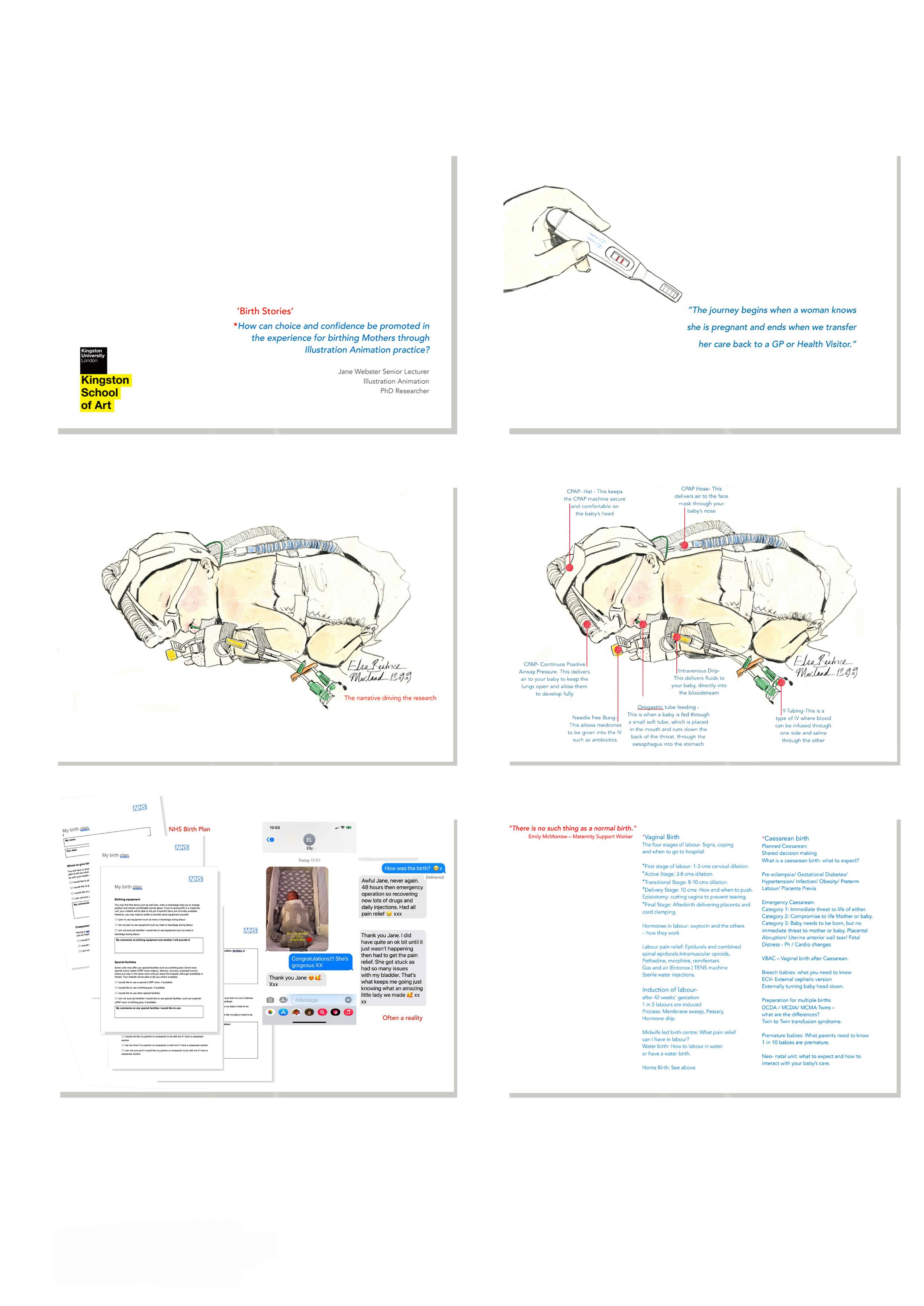
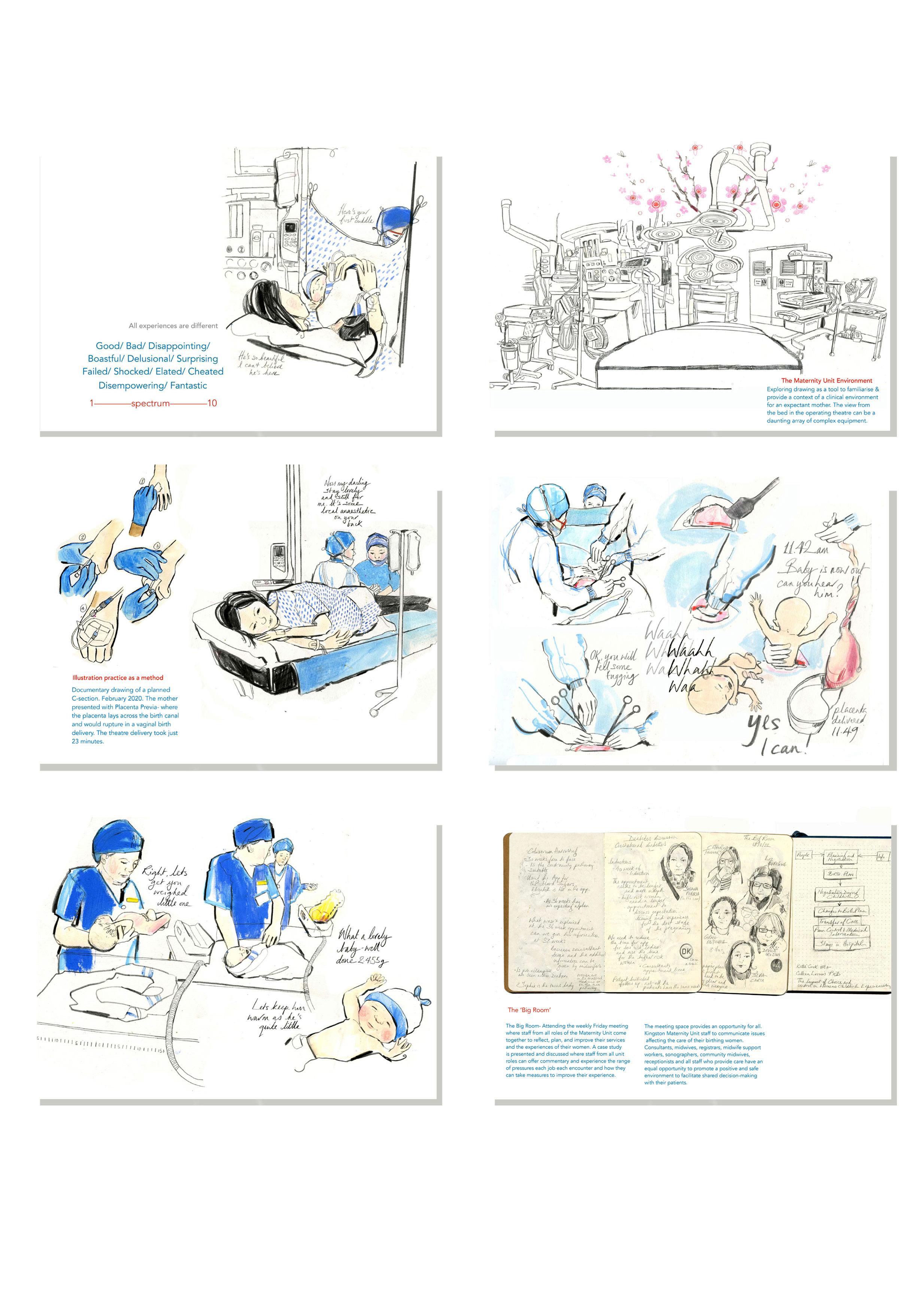

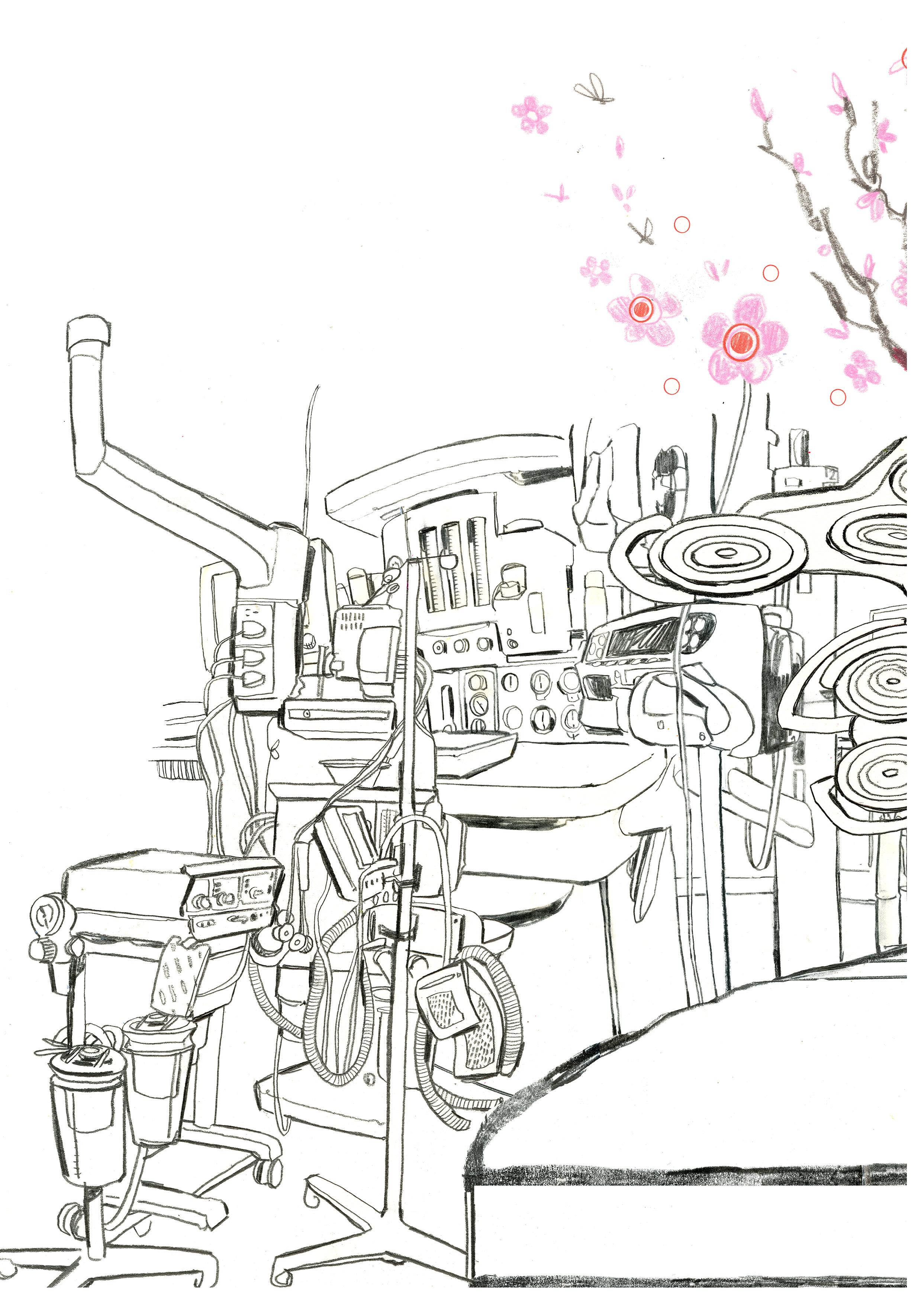

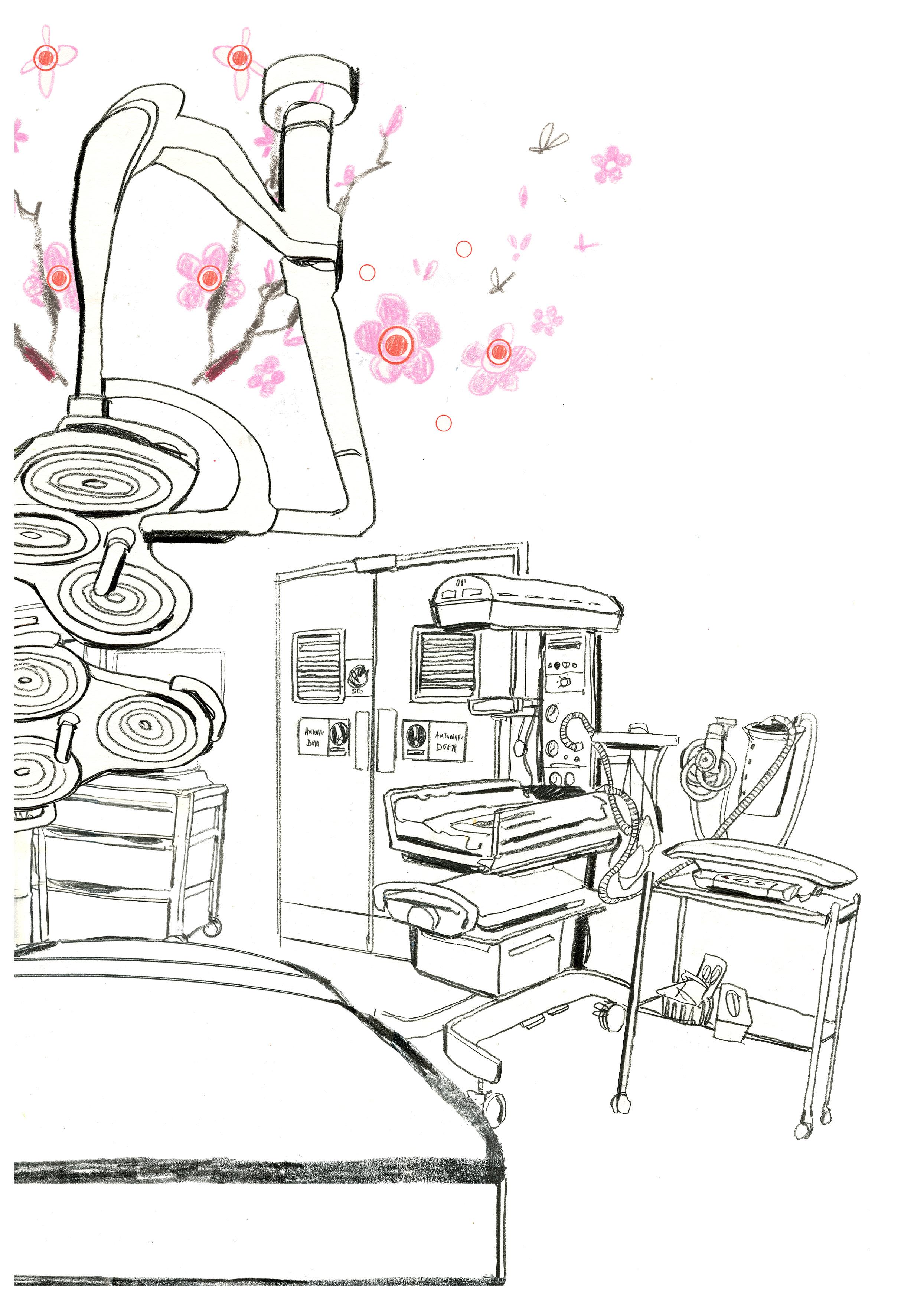

Kingston Hospital’s Maternity Operating Theatre. The environment for planned and emergency C-Sections.
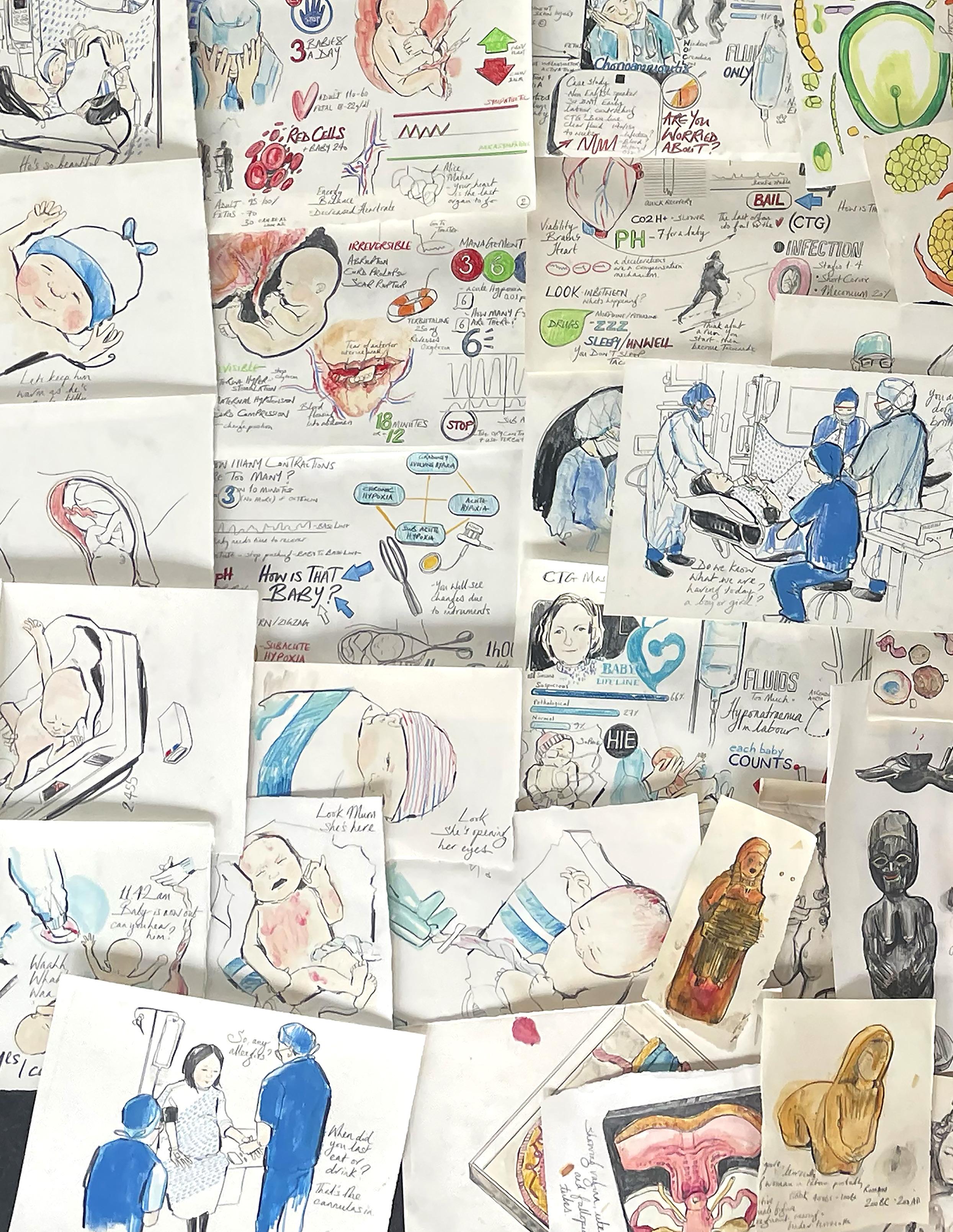 Selection of drawings from year one, Collections, previous visits to KMU, Birth Rites, and Baby Life Line Talks.
Selection of drawings from year one, Collections, previous visits to KMU, Birth Rites, and Baby Life Line Talks.
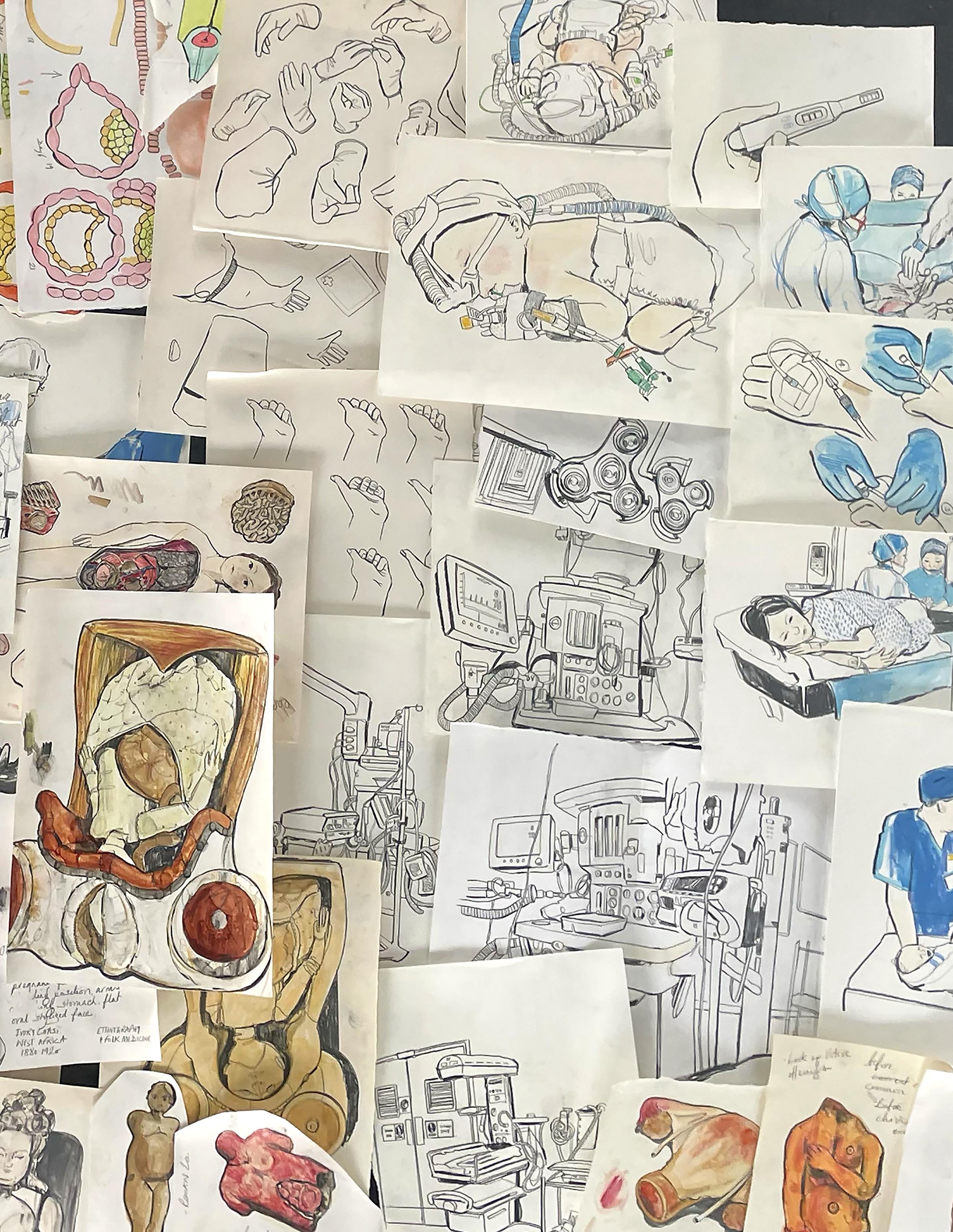
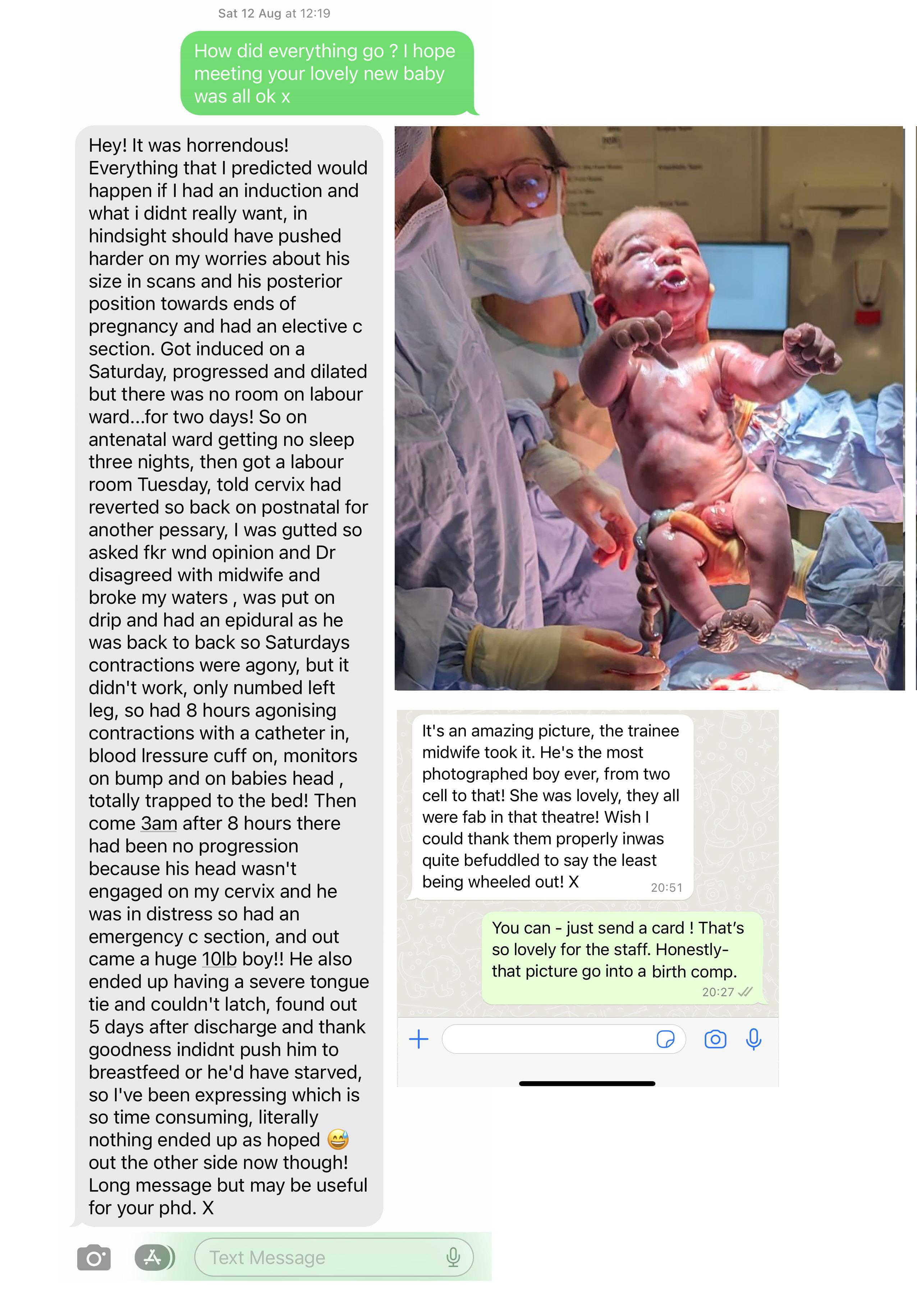
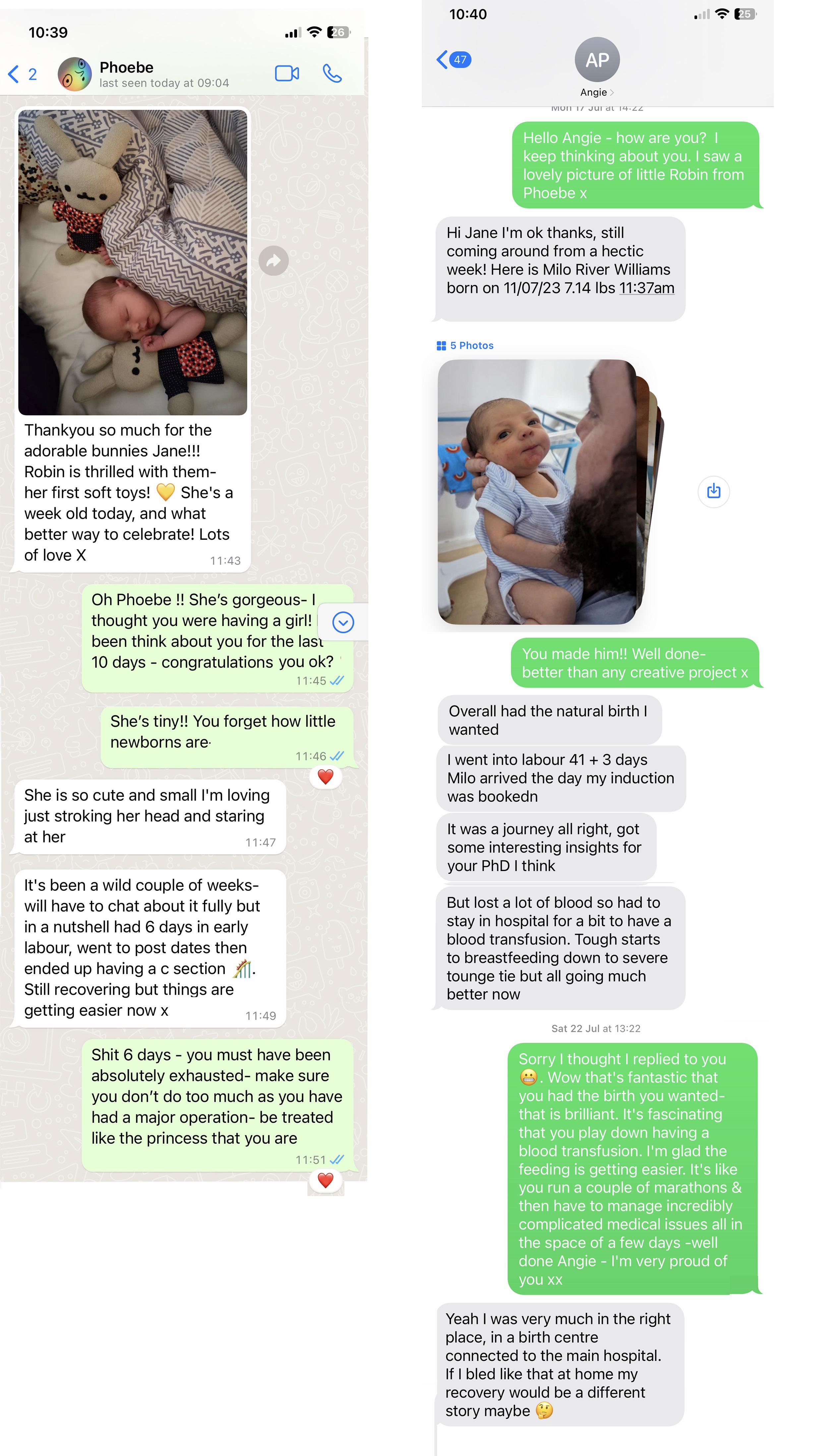
*BADASSMOTHERBIRTHER
Flor Cruz is an advocate for the normalisation of birth. She’s an American woman who works as a doula and runs birthing classes, a website full of information. Cruz hosts an enormously successful Instagram presence of 820 thousand followers. After her first disappointing birth experience of her child, a breech baby and a c-section, which she felt bullied into. She’s committed to spreading awareness and the normalisation of the birthing process. Within her online presence, she shares uncensored and raw images of birth: some photos and many videos from around the world. Cruz aims to advocate and allow women to understand that they have a choice in how they’re treated along the pregnancy journey and in the delivery setting.
Her website https://badassmotherbirther. com/ has a visual language akin to a tattoo parlour. She introduces herself as
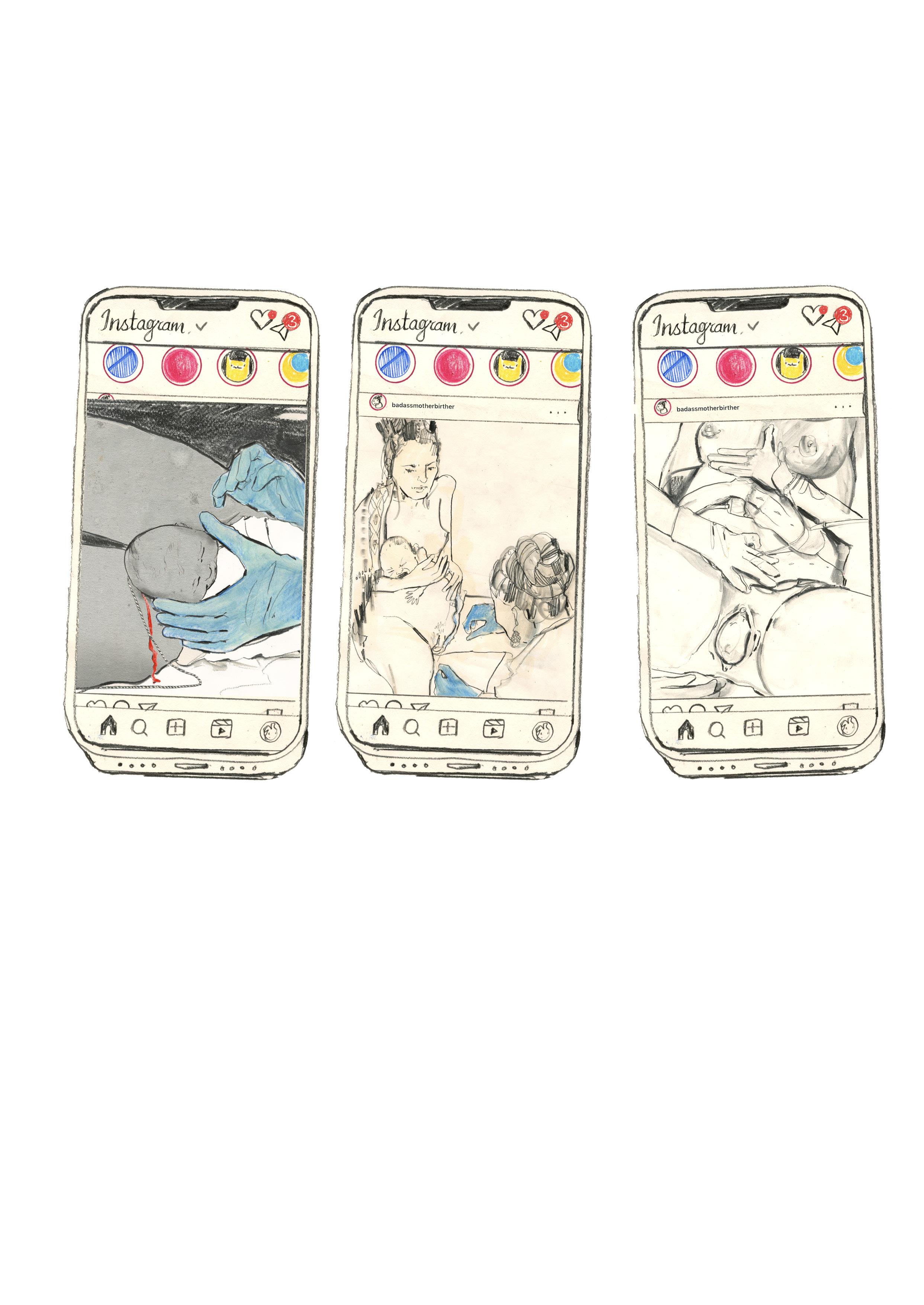
‘DOULA+INFLUENCER+ADVOCATE’.
Set out are the stories of her three very different experiences. In the disappointing C-section, the hospital VBAC and her home birth. In the third experience, she chose to have no interventions and no cervical checking for dilation. This birth story isn’t saccharin, and the baby has a shoulder dystopia- where a shoulder becomes stuck in the birth canal. Knowledgeable midwifery deals with this scenario, and her baby son is fine. She has no tearing and records the experience. ‘I want you to see and hear my story of my home birth, my 2nd VBAC, and how competent midwifery care can be. That emergency can be handled at home. That my team would have indeed called an ambulance and transferred me to a hospital if I or my son needed it. But we didn’t, and I’m beyond amazed by the expertise of my team.’ Her experiences have led to
her career working with midwifery professionals to host birthing classes on Zoom - so they can be attended anywhere in the world. She publishes images and stories of women showing empowering birth positions, which feel right and natural. Not feeling that you have to ask and have permission on positioning and choices in birth. America has the most significant baby mortality rate in the developed world and the highest ceasarean rates. Badassmotherbirther provides a space for women to compare stories, seek solace and feel advocated in seeing and normalising the seeing of women’s births. Interestingly, 60 per cent of the stories on her Instagram page are behind a censored ‘watch at your own peril’ warning. The one and only thing we all have in common is that we have all been born. Why does it remain such a taboo and uncomfortable subject? We simply don’t see births.
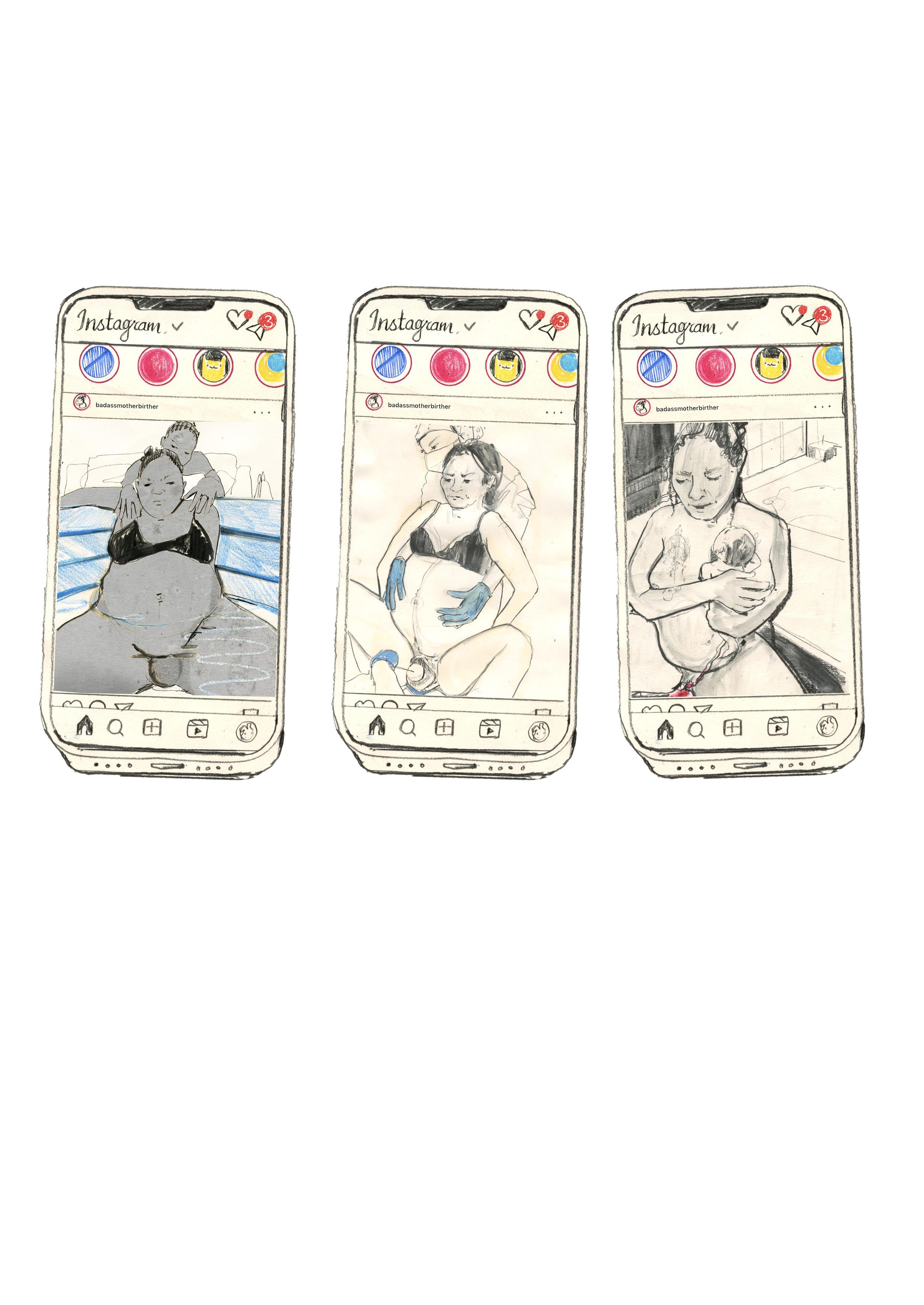
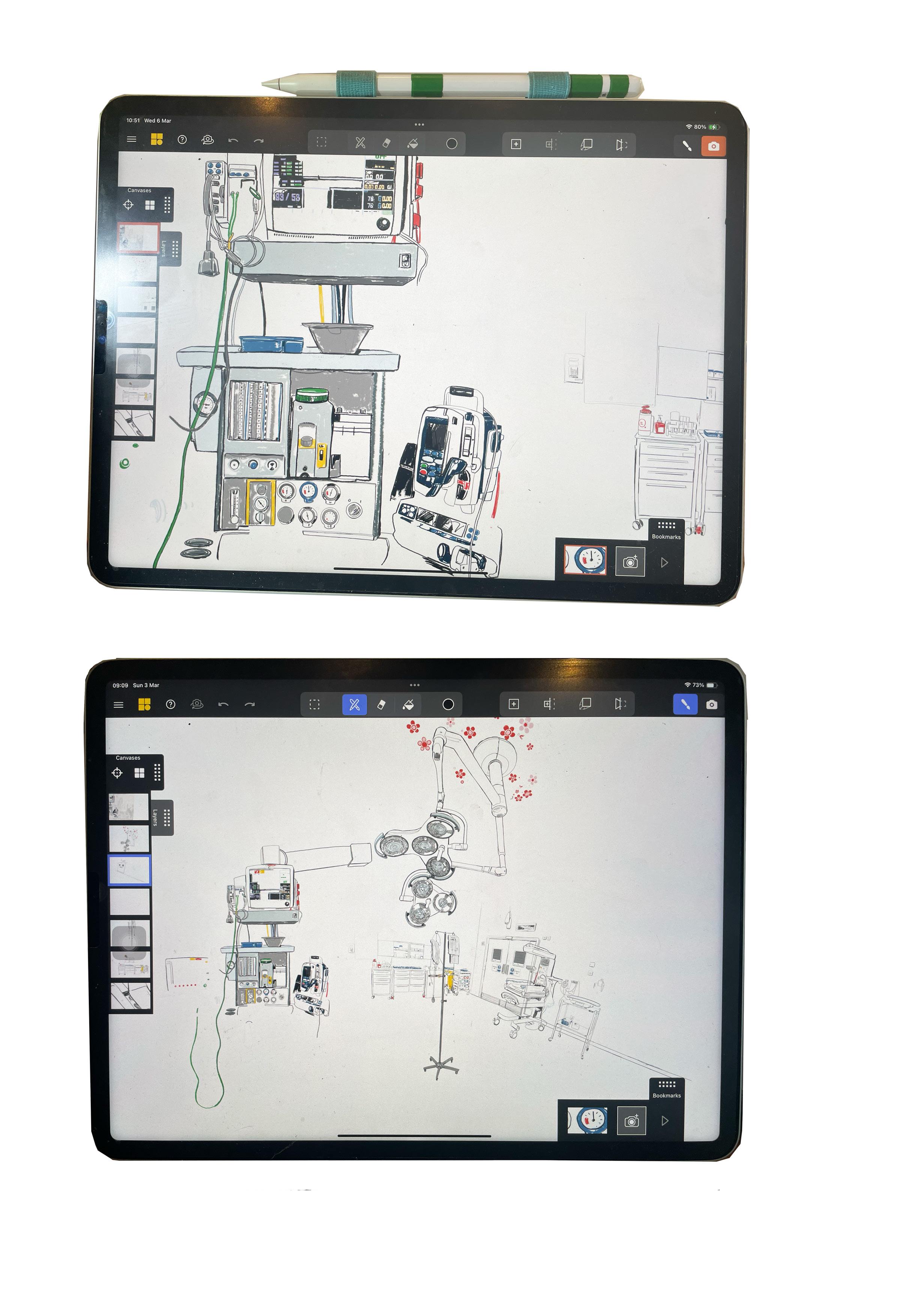
This a the description of the software in a paper published by the developers
The Mental Canvas: A Tool for Conceptual Architectural Design and Analysis Julie Dorsey Songhua Xu Gabe Smedresman Holly Rushmeier Leonard McMillan§ Department of Computer Science Department of Computer Science Yale University The University of North Carolina at Chapel Hill
Abstract We describe a computer graphics system that supports conceptual architectural design and analysis. We use as a starting point the traditional sketchbook drawings that architects use to experiment with various views, sections, and details. Rather than interpret or infer 3D structure from drawings, our system is designed to allow the designer to organise concept drawings in 3D, and gradually fuse a series of possibly geometrically-inconsistent sketches into a set of 3-D strokes. Our system uses strokes and planar “canvases” as basic primitives; the basic
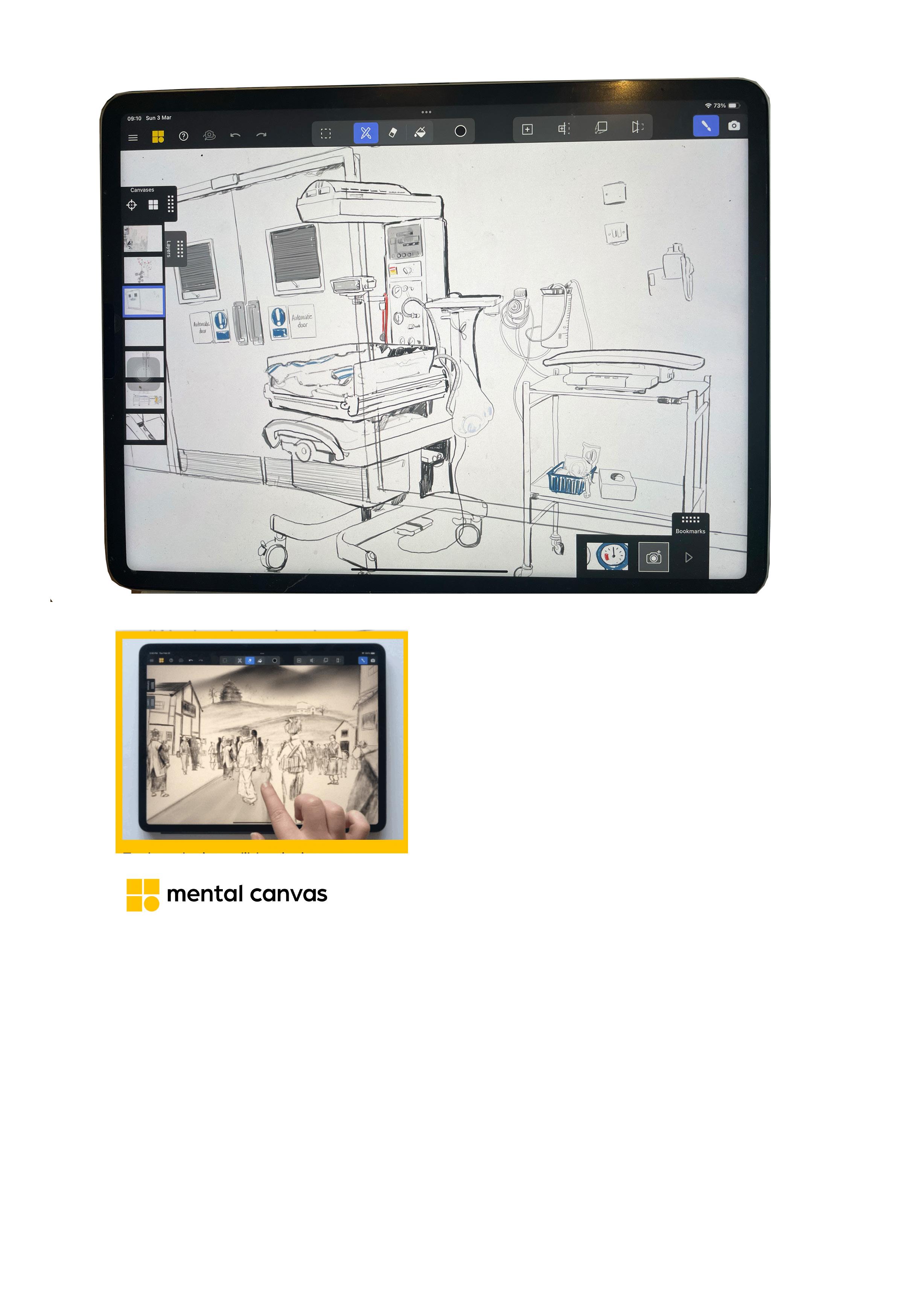
mode of input is traditional 2D drawing. We introduce methods for the user to control stroke visibility and transfer strokes between canvases. We also introduce methods for the user to position and orient the canvases that have infinite extent. We demonstrate the use of the system to analyse existing structures and conceive new designs. 1 Introduction Architects use drawing as an aid to visual thinking System Description A 3D sketch in our system is built out of invisible planar 2D surfaces, which we call canvases. These canvases can be positioned and rotated in 3D space, using the traditional CAD tools of position, rotate, and scale, on three coordinate axes, using the tablet pen. Though they are theoretically infinite in extent, they are drawn with finite borders so that the user can easily see their orientation on screen. Only one canvas can be active at any time. A canvas is made active by clicking on the corner of its on screen border. The user draws
with the tablet pen, and sets down strokes directly on the active canvas. By rotating the camera view with the arrow keys on the keyboard, the user can draw on a canvas from any angle; the pen position is automatically projected onto the appropriate point on the canvas surface. For quickly exploring new ideas or changes, a view canvas can be created. https://graphics.cs.yale.edu/sites/default/files/low-resolution_pdf_file_0.pdf
The left-hand side has the layers of the drawing - so, in this case, the walls and the different pieces of equipment in the operating theatre. The bottom frames can be selected as points that you can move around the room - giving the viewer a chance to virtually enter and move around a new or different space. The patient can know what is in a particular clinical setting through drawing and understanding their viewpoint as a patient and seeing complex equipment on their terms before being moved into a clinical setting. What size is the space? What is my perspective? What are all the things I will possibly be hooked up to?
I am in the early stages of exploring the potential of this software. As an illustrator, images and environments can be drawn straight into an iPad, or more traditional paper imagery can be scanned and imported into the software. Mental Canvas acts like a stage set, where you, as the viewer, can move around the stage and see behind the scenes. Through illustration practice, this software has vast potential in introducing patients and family members to the medical journey and what space in a hospital setting will look like, to reduce the anxiety of visiting a new and unfamiliar setting.
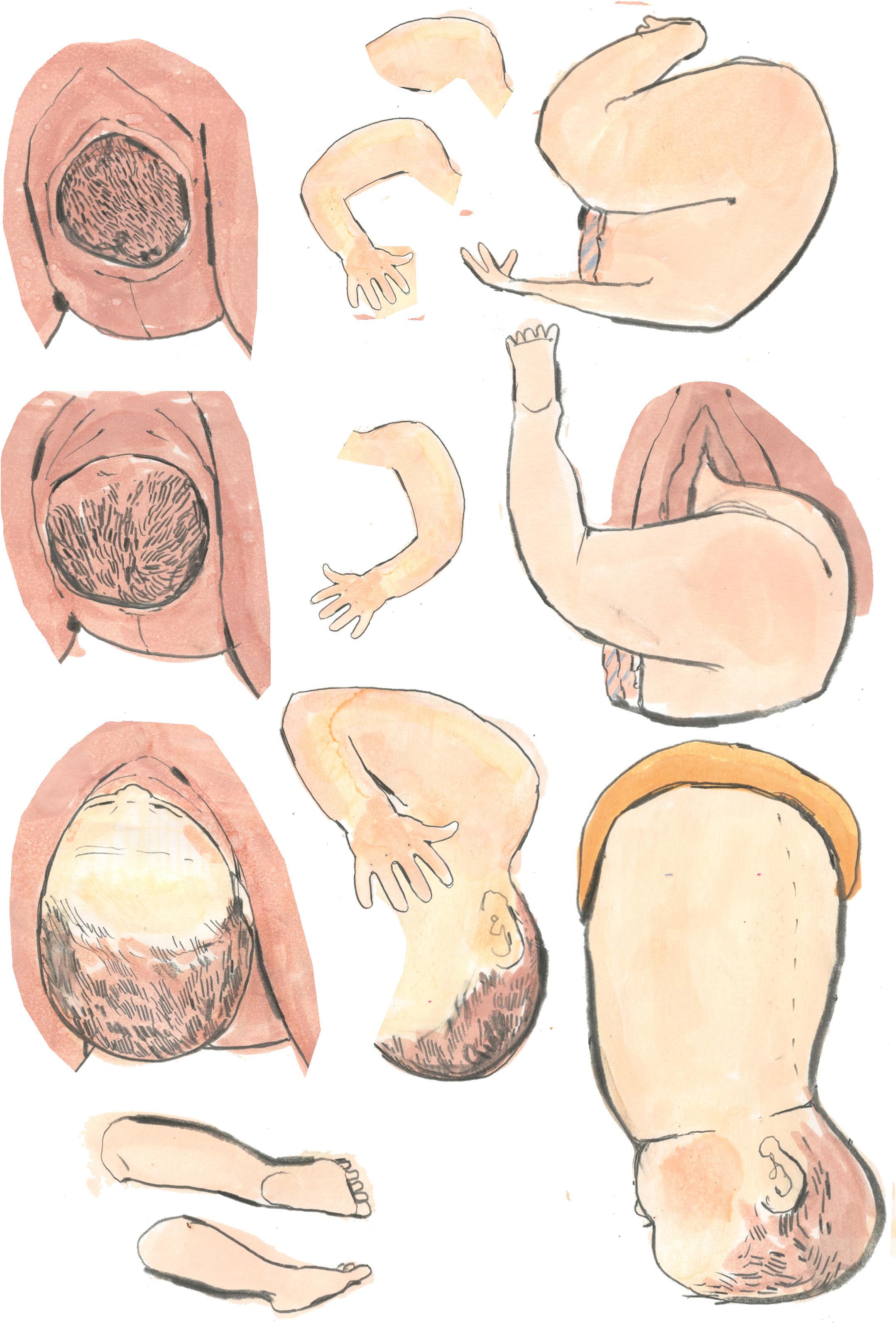
These four pages of elements have provided the material to be able to join the jigsaw of components to create the birth sequence. The layers of hands and other fluids need working out - it’s in progress.

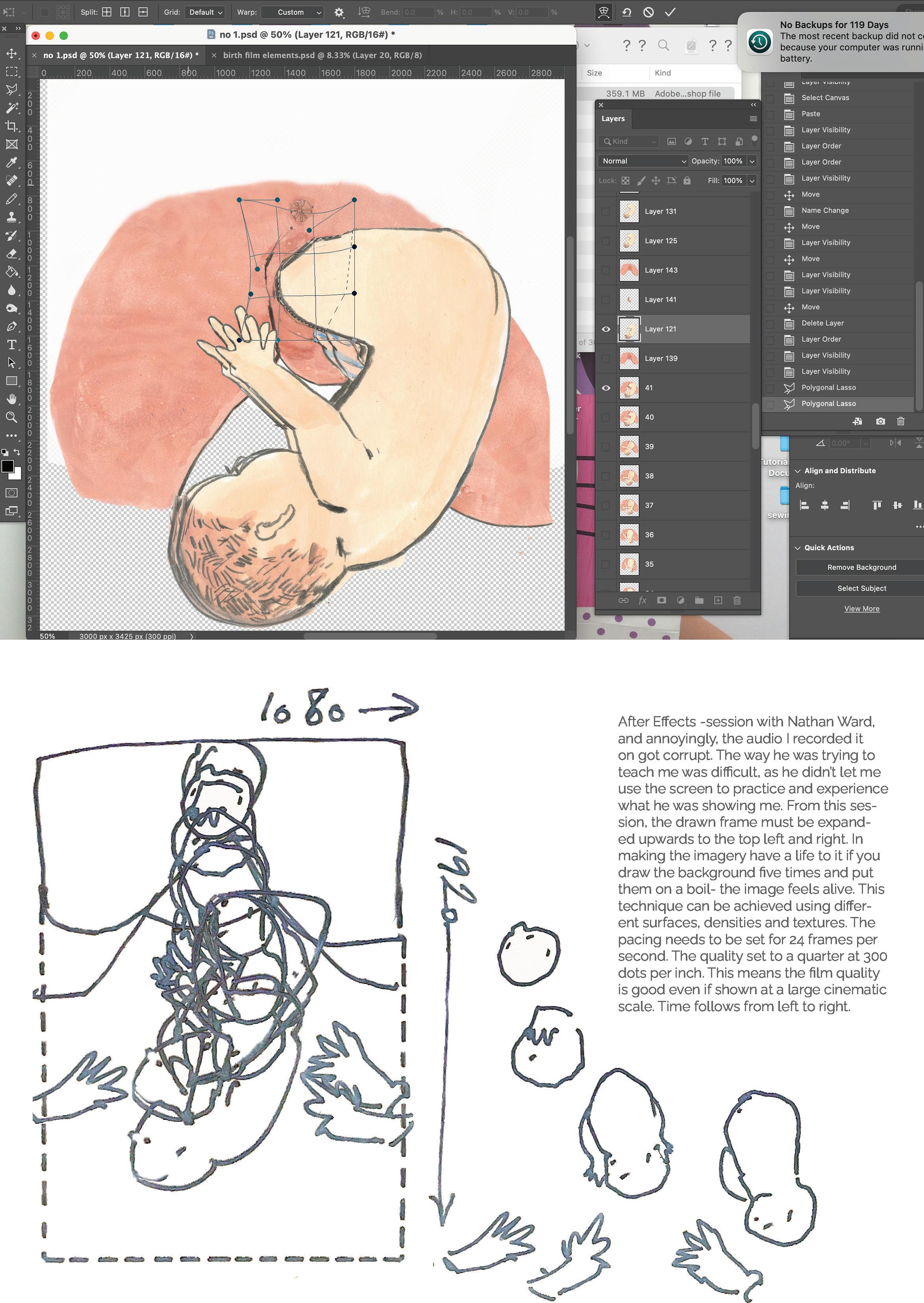
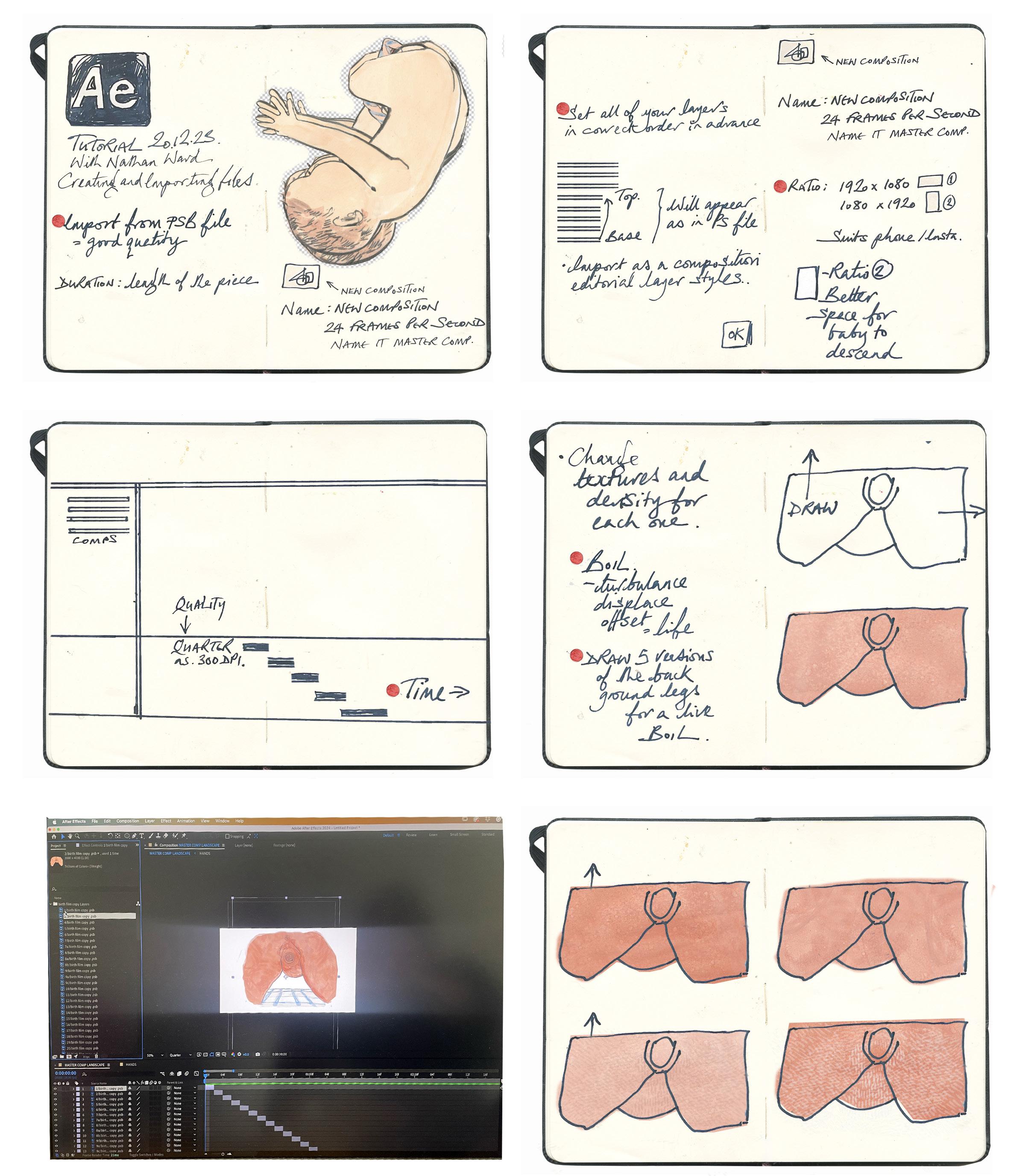
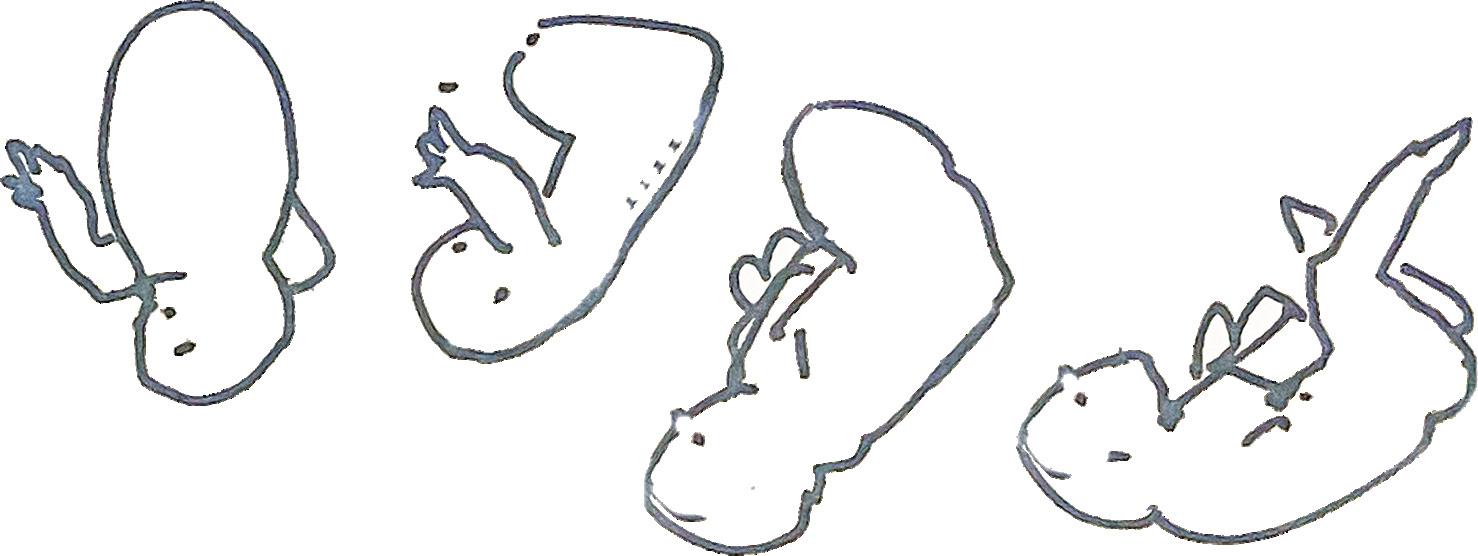
Moving Image or static image?
Note from Tutorial 15/01/24.
The boils and movement make the animation feel more like it’s not just flat or still. What you’re doing is you’re putting energy into time because traditionally you’ve drawn what’s in front of you, in a documentary sense of images, and that is then the communication, but have you got a strategy for why a moving image is going to be more helpful? GG
No, I don’t. I’m trying to determine whether it works better as a sequence of not moving or moving. JW
It’s worth documenting in your research because there’s a big difference between static and moving images. GG
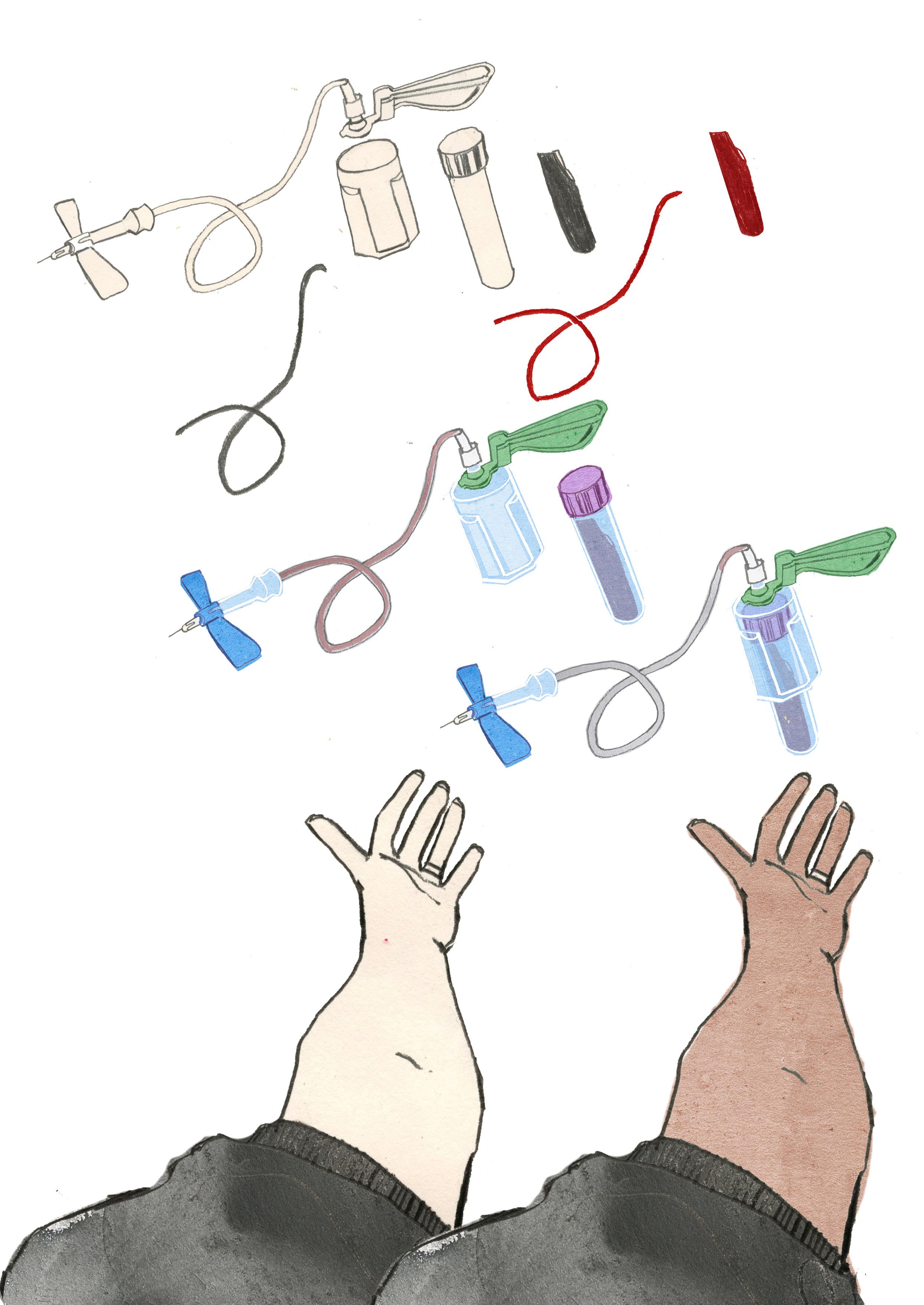
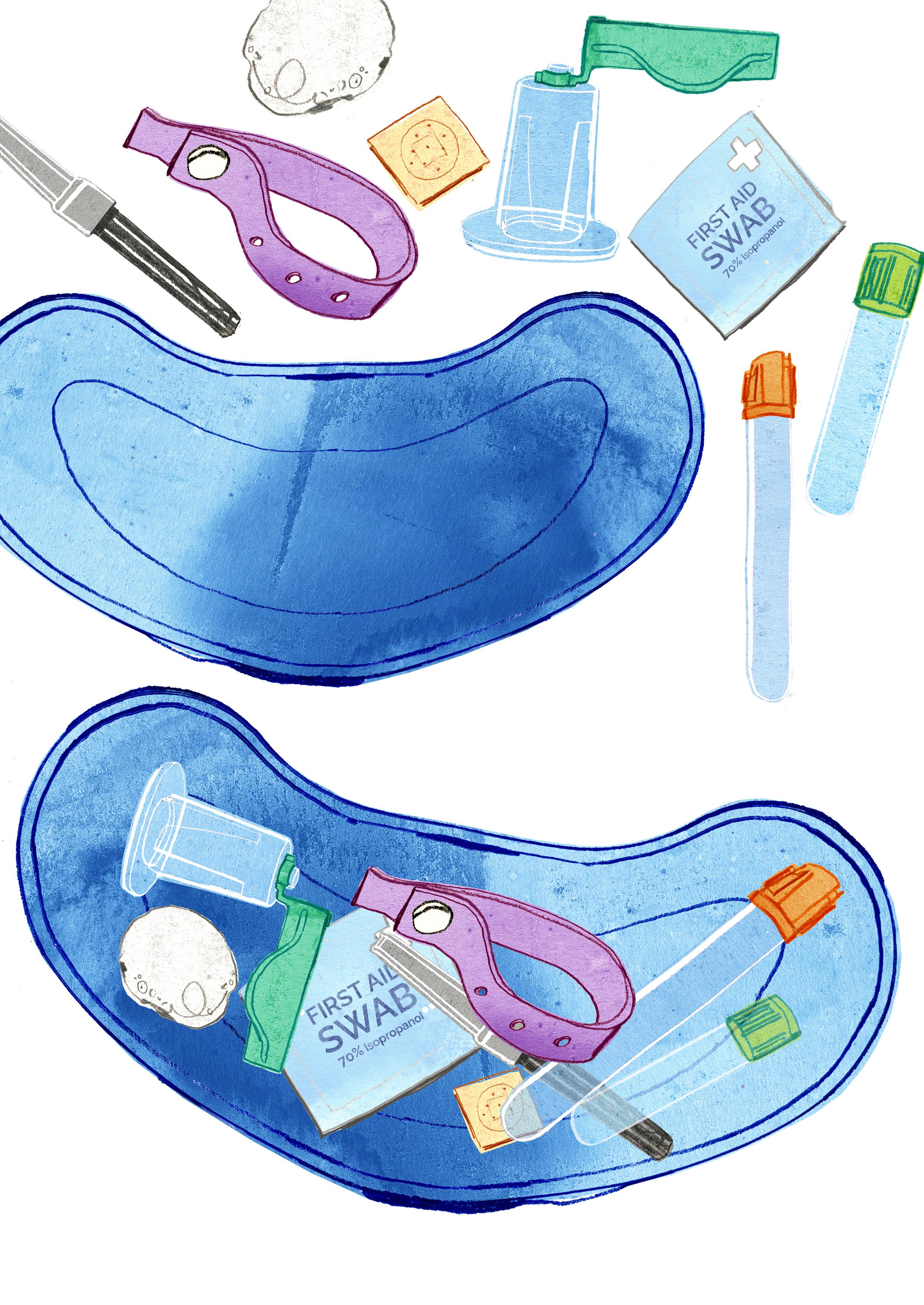
Blood Testing
I was surprised when listening to a maternity support worker - Emily, at Kingston Maternity Unit. She outlined the fear and misunderstanding many women have when it comes to the experience of staff taking bloods at the beginning of a pregnancy. The needle will be much bigger, and the amount of blood taken will be much more than the reality. These drawings explore how somebody can show the process of taking blood in a short animated film that can be seen on a phone if wanted before the hospital visit. The process can be an audio layer, potentially in different languages so that non-English speaking patients can be aware of the experience.
